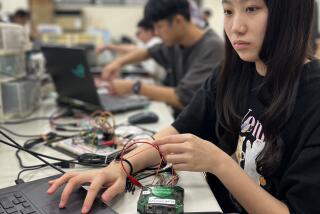Asia/Pacific Firms’ Share of Chip Market Grows
Asia/Pacific semiconductor companies were the only regional group to increase their share of 1989’s $55.8-billion worldwide semiconductor market, according to Dataquest’s annual survey.
Led by South Korea’s Samsung, Asia/Pacific firms (which exclude Japanese firms) experienced a phenomenal 43% growth rate. They gained a percentage point of worldwide market share, increasing their piece of the pie to 4%.
This region’s growth is attributed to the companies’ concentration on the dynamic random access memory, or DRAM, market. But current dramatic price declines in DRAMs could turn continued emphasis on DRAMs into a liability.
The recent survey of 120 semiconductor companies around the world found that, overall, 1989 was a lackluster year for the industry, which grew only 10% worldwide, compared to nearly 33% in 1988.
Manufacturers in Japan and Europe managed to hold on to their shares of the market, but North American firms lost share for the second consecutive year. Japan firms are still clearly the world market leader, maintaining a 51% share. European firms held at 10% of the world market, but North American firms’ share dropped to 35% from 37% in 1988.
Japanese firms’ dependence on exports rose in 1989. That strategy kept them even at home but allowed them to increase their semiconductor business in North America. Japan now supplies 24% of the North American semiconductor market, up from 21% in 1988. North American firms have maintained their 10% market share in Japan.
Color Copier Makers Look to Business Sector to Expand
Color copiers saw a banner year in 1989 with nine new, full-color copier introductions. There are now 13 models available in the United States. And the color copier market is expected to take off in the next few years.
Although Xerox introduced the industry’s first successful color copier in 1973, the market had grown to only $56.6 million by 1985. Price, lack of adequate technology and perceived lack of usefulness within the business world stifled the growth of the industry.
However, the technology advancements needed to bring color copiers into mainstream American businesses and lower prices have given a boost to the industry. Between 1987 and 1992, the U.S. color copier industry is expected to have a compound annual growth rate of 45.5%. The value of the market was estimated at $433.2 million last year, and by 1992, it is expected to reach $1.7 billion.
In addition to the full-color copiers introduced in 1989, Canon, Panasonic, Savin and Sharp offer copiers with both full-color and black-and-white copying modes. The availability of dual-function copiers opens the office market to color copiers.
Furthermore, most major black-and-white copier manufacturers announced in 1989 that they plan to make or distribute a full-color copier. Canon, Sharp and Ricoh said they will market more than one color copier.
Yet, despite the ample availability, there is little awareness among users of the possibilities of color copiers in business. Manufacturers have tended to concentrate marketing efforts on their dealers and to overlook those who use the machines. Efforts are being made to advertise the existence and applications of color copiers to users.
Netherlands Seen as Gateway to Europe for High-Tech Firms
High-tech companies looking to get a foothold in Europe before the unification of the European Community in 1992 might consider setting up shop in the Netherlands.
Building on its reputation as one of Europe’s premier distribution centers, the Netherlands has an aggressive high-tech development strategy, and a host of government programs and agencies, spearheaded by the Netherlands Foreign Investment Agency, are in place to attract high-tech companies. For example, the Dutch government has made available research grants of up to $650,000 on the condition that any resulting products are made, at least in part, in the country.
In addition, technical development loans at 5% interest are available to companies with fewer than 20,000 employees to fund 40% to 60% of product development costs. Other investment incentives can cover 25% of fixed capital costs for companies establishing business links in the Netherlands.
Besides government funding and an automated distribution network, the Dutch have been particularly active in promoting their venture capital industry. Government-sponsored organizations were created to spur the growth of the venture capital industry.
Although the country’s existing industrial base and internal market are small compared to those of France, the United Kingdom and West Germany, the Dutch have tapped larger markets by acting as a conduit for goods entering Europe. And, with English mandatory in its schools, the Netherlands has the highest ratio of multilingual nationals in Europe.






